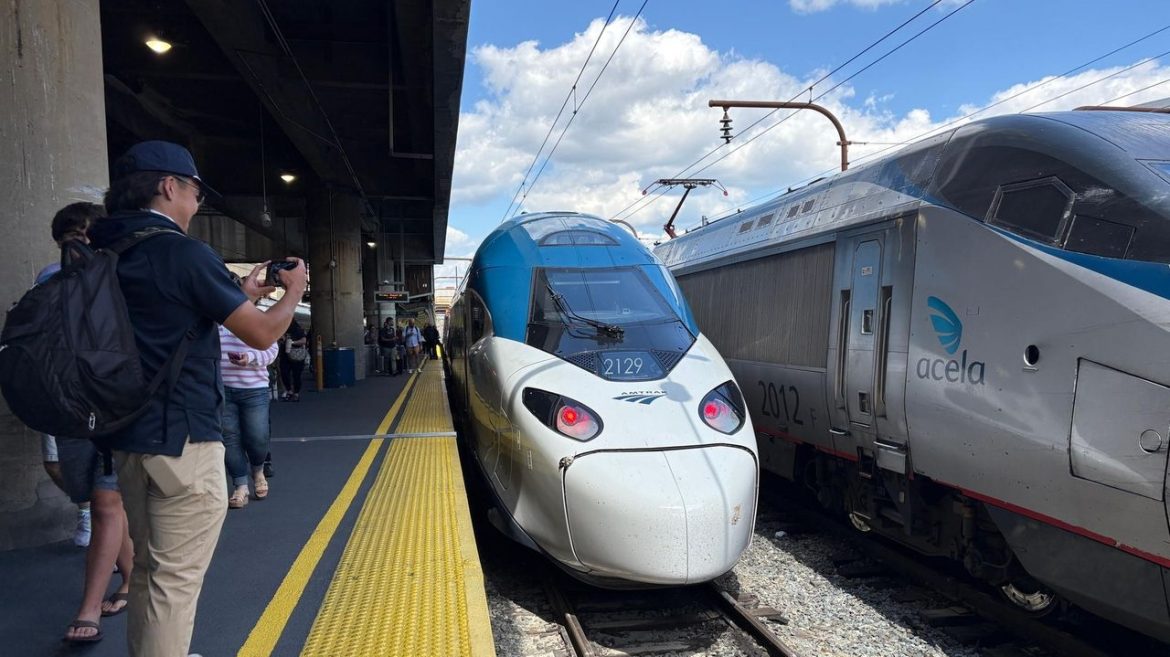On Aug. 28, Amtrak debuted its first batch of long-awaited NextGen Acela trains in the Northeast Corridor. It was a momentous occasion for the passenger railway company; the NextGen trains are the first major upgrade to the Acela since it arrived at the end of 2000 as Amtrak’s first premium, high-speed service, offering travelers a faster way to get to stops between Boston and D.C.
Built by French manufacturer Alstom at a plant in New York, the new Acelas can reach top speeds of 160 mph — 10 mph faster than the older version — and are designed to tilt around curves more easily, among other upgrades like better Wi-Fi and updated electric outlets. Five of the 28 new high-tech train sets have started running, and the rest will roll out gradually over the next two years.
Their arrival comes after years of delays due to testing complications and old infrastructure. Were they worth the wait?
I booked a round trip from D.C. to Philadelphia on NextGen’s second day of service, after the first wave of TV crews, journalists, transit bloggers and influencers took their spin.
My ticket was $368, maybe due to high demand or the fact that I made the reservation a week and a half before the trip (the closer to departure, the more expensive the Amtrak fare, usually). If I had booked later in the future — even just by a couple weeks — I could have done it for as low as $124.
Here’s everything I noticed on my ride.
A new, sleek look
At Union Station on the morning of my trip, there were signs for NextGen everywhere, from a 3D miniature model on display in the middle of the lobby to advertisements for them on ticket kiosk screens.
The new trains have a sleeker, more contemporary design compared to the original Acelas, although they’re not nearly as futuristic or fast-looking as Japan’s famous high-speed Shinkansen (capable of going 200 mph) or China’s Maglev (top speed: 268 mph). The United States’ own magnetic levitation train plan was recently deemed unfeasible.
Bigger, brighter touches
On board, the train felt like a breath of fresh air. The car was bright and airy, the bathrooms were huge. There’s nice lighting and large windows. Like other Amtraks, the seats face in mixed directions, and some have tables.
One funny quirk of the car is the luggage racks above the seats unintentionally double as mirrors. Because of their transparent design, they display the reflection of the passengers below, so I could very clearly see a fellow traveler halfway down the car sleeping, mouth agape.
It made me self-conscious: Would other travelers be watching me drool during a nap?
The Wi-Fi is better
Amtrak has had a terrible reputation when it comes to its onboard internet service. I’m usually so frustrated with train Wi-Fi, that I give up and use my phone as a hot spot, so I was eager to try their new “free, 5G-enabled” Wi-Fi.
I worked on my laptop during both legs of my trip and noticed the difference immediately. For the data-driven readers, I ran a few free speed tests and was told my connection should be able to handle streaming HD videos. That seemed accurate; I was able to work pretty smoothly and mindlessly scroll through social media videos throughout the ride.
But it still had its flaws; I did get notifications that my Wi-Fi had disconnected, and there were some periods where it seemed to lag.
Overall, it was a huge improvement — even if the bar had been low.
Firmer seats
Amtrak said there would be 27% more seats per departure on the new trains which made me wonder: Would the seats be smaller to accommodate more of them?
Fortunately, no. A spokesperson for Amtrak told me that the length of the entire train is longer and that “NextGen Acela seats are higher, wider, and deeper in First Class and Business Class compared to FirstGen Acela.”
As I took my recycled leather seat in business class — Acelas do not have a coach class, only business and first — I was surprised by the seat’s firmness. They felt extremely firm and rigid, like sitting on a taught piano bench. And even if they’re technically wider than FirstGen Acelas, they do feel more narrow than what you’d get in coach on a Northeast Regional.
A fun touch, though: Each seat is equipped with a reading light.
A new way to recline
You’re in for a shock when you go to recline. Instead of a typical back bend, the seats slide down and forward.
Better bathrooms for babies

The bathrooms on the new Acelas are large and have baby changing stations. Credit: TWP
Not all Amtrak trains have changing tables. The NextGen Acela bathrooms do! That’s a win for parents.
Polarizing outlets
Each seat has easy access to an electrical outlet, as well as a USB-A port. This felt dated, as most of my electronics use USB-C plugs these days.
That opinion will differ depending on who you talk to; there are still plenty of electronics that do require USB-A chargers — and people who prefer them.
The cafe car prioritizes grab-and-go

Inside the NextGen Acela cafe car. Credit: TWP
It’s fitting that the cafe car is not called the dining car; it’s for procuring your food, not savoring it. There is no seating — nary a stool — to be found, but there is standing room if you don’t mind eating or drinking standing up.
Along the wall near the cash register, travelers can pick up a grab-and-go item from display cases filled with sandwiches, salads, antipasto boxes, soft drinks and water. Passengers can also order from a larger menu of Amtrak classics like the Hebrew National hot dog or white Cheddar mac and cheese.
On my first leg, I got a sausage and Cheddar breakfast sandwich on a bialy ($8) and a cup of black coffee (La Colombe, $3.50) — both serviceable but nothing to write home about.
No water filling stations
In a loss for customers who care about the environment (or not spending $4.50 on a Smart Water), the new trains do not have filling stations or water fountains.
Life is better in first class …

First-class diners can order food, like this Korean short rib meal, from their seats. Credit: TWP
Amtrak customers can bid on upgrades instead of paying full price for a better ticket. I rolled the dice and put a $108 bid. Even though the app told me this was just a “fair” attempt, it was accepted, and I was upgraded for my return to Washington.
This was where the real train geeks were. There were multiple people on board who were there for the ride alone, not as transportation. They would pause in D.C. and turn back to their homes in New York, Connecticut and Boston.
My first thought as I took my seat in first class: They installed USB-C adapters! Each seat was equipped with a removable adapter, so customers could use either a USB-A or C.

In first class, passengers were given USB-C adapters in their USB-A charging ports. Credit: TWP
My second thought: The first-class seats didn’t feel too different from business (except that instead of a two-by-two seating configuration, there’s a row of solo seats and a row of two-seaters). The real difference is in the service.
A server handed me a hot towel as soon as I got situated; there was a more elaborate food menu I could order from, and my meal (Korean BBQ short rib with fried rice and snap peas) was served with metal cutlery and a cloth napkin. It came with a cup of key lime cheesecake, a croissant and a pat of butter. Naturally I had to try the cocktails, so I got a “Zing Zang Bloody Mary” that was potent and flavorful. This was living.
… but not perfect
When I actually bit into my food, my opinion of first class went down a notch. It tasted like it had all been microwaved to oblivion, save the short rib which was tasty and tender. The croissant was so tough it was like biting into beef jerky. The cheesecake cup wasn’t worth a second bite. My quest to find what food Amtrak does best continues.
Not always a faster ride
Unless you’re traveling farther north, don’t expect to hit those 160 mph speeds. There are four segments — covering 70.6 track miles — where the train can reach top speed: one in New Jersey, two in Rhode Island and one in Massachusetts.
Otherwise, the tracks, among other factors, hold the new trains back from reaching their full potential. They’re working on it; Amtrak’s 2040 plans estimate an Acela trip between D.C. and New York will be 20 minutes faster than its current two hours and 50 minutes.
Each leg of my trip to Philadelphia took about an hour and a half, the same as it would had I taken the old Acela. According to my free Speedometer app, our top speed was 134 mph on the way from D.C., and 147 mph on the way back. (That’s still typically faster than driving or taking the Northeast Regional).
A win for America
Did the NextGen drop catch us up with the trains of Japan? France? China? No. But this one small step for the Northeast felt like one giant leap for the U.S.
Rachel Weiner contributed to this report.
#Amtraks #NextGen #Acela #trains #debut #Northeast #Corridor



